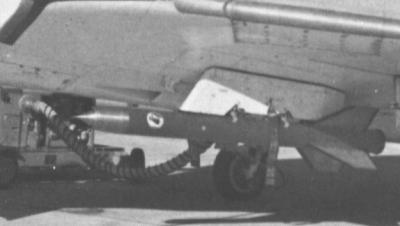Naval Missile Center Crow
In July 1956, the U.S. Naval Air Missile Test Center (which later became the Naval Missile Center) in Pt. Mugu began to study solid propellant grains for use as ramjet fuel in long-range missiles. After thorough ground testing of all critical components, including solid-propellant ramjet combustions tests, the Crow flight test vehicle was built.
The Crow I vehicle was an unguided air-launched ballistic rocket, powered by a solid-fueled rocket motor and a solid-fueled ramjet, and stabilized by four fixed tail fins. After launch from an F4D-1 Skyray carrier aircraft at about 10700 m (35000 ft), the rocket propelled the vehicle to a speed of Mach 3+. At burnout, the ramjet was ignited and the now empty rocket motor casing served as the combustion chamber of the ramjet, which burnt fuel from the center section of the vehicle. After several captive flight tests, the first Crow firing was attempted on 19 January 1961. However, the rocket motor did not ignite because of a design error in the launching mechanism. After this had been identified and corrected, two Crow vehicles were successfully test flown on 14 and 22 November 1961. The Crow I thus became the United States' first flight test article with an integrated solid-fueled rocket/ramjet propulsion system.
 |
| Photo: U.S. Navy |
| Crow I (ballistic vehicle) |
The unguided Crow I was a pure propulsion test vehicle, and it was planned from the beginning to conduct follow-up research on guided derivatives. The controlled Crow was equipped with tail-mounted wings and fins in an "H" configuration and movable canards. From February 1963 to May 1965, this vehicle was used to test a missile autopilot using an "infrared horizon-scanning" technique. After the autopilot had been tested in several captive flights, four Crow missiles were launched from F-4B Phantom II aircraft between 29 May 1963 and 6 May 1965. However, in the first three flights the Crow failed only seconds after release, and the fourth one wasn't fully successful either. The reasons included mechanical and electrical malfunctions in the missile's rocket motor, control surfaces and autopilot.
 |
| Photo: U.S. Navy |
| Crow (controlled vehicle) |
Although the Crow program successfully verified the concept of interal solid-fueled rocket/ramjets, there is not yet any production missile in the U.S. arsenal which uses this kind of propulsion.
Specifications
Note: Data given by several sources show slight variations. Figures given below may therefore be inaccurate!
Data for Crow I (ballistic vehicle):
| Length | 2.91 m (9 ft 6.4 in) |
| Diameter | 20 cm (8 in) |
| Finspan | 71 cm (28 in) |
| Weight | 140 kg (300 lb) |
| Speed | Mach 3+ |
| Propulsion | Solid-fueled integral rocket/ramjet rocket: 44.5 kN (10000 lb) for 2 s ramjet: 0.98 kN (220 lb) |
Main Sources
[1] G.C. Googins et.al.: "Crow I Ballistic Flight Tests", U.S. Naval Missile Center Pt. Mugu, 1963
[2] R.L. Mangini: "Flight Tests of the Crow Horizon-Scanning Autopilot", U.S. Naval Missile Center Pt. Mugu, 1966
Back to Directory of U.S. Military Rockets and Missiles, Appendix 4
Last Updated: 16 November 2004